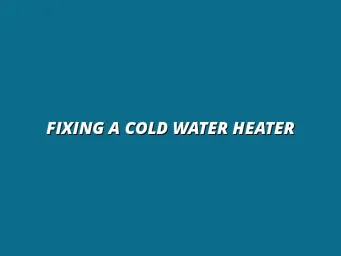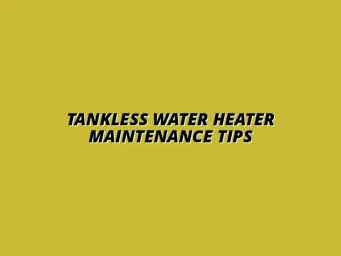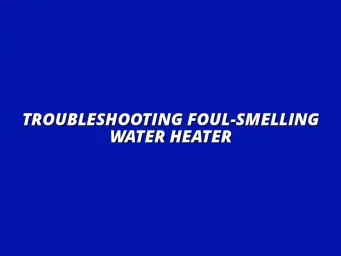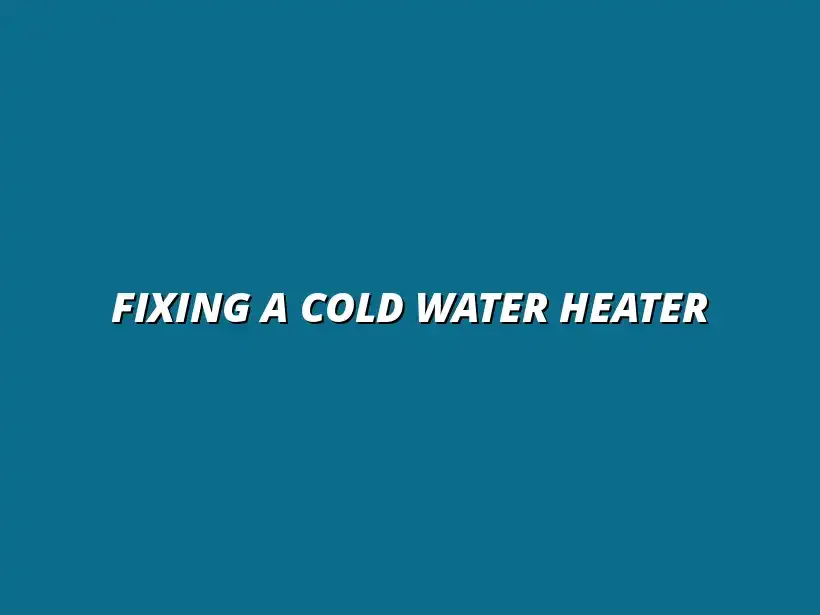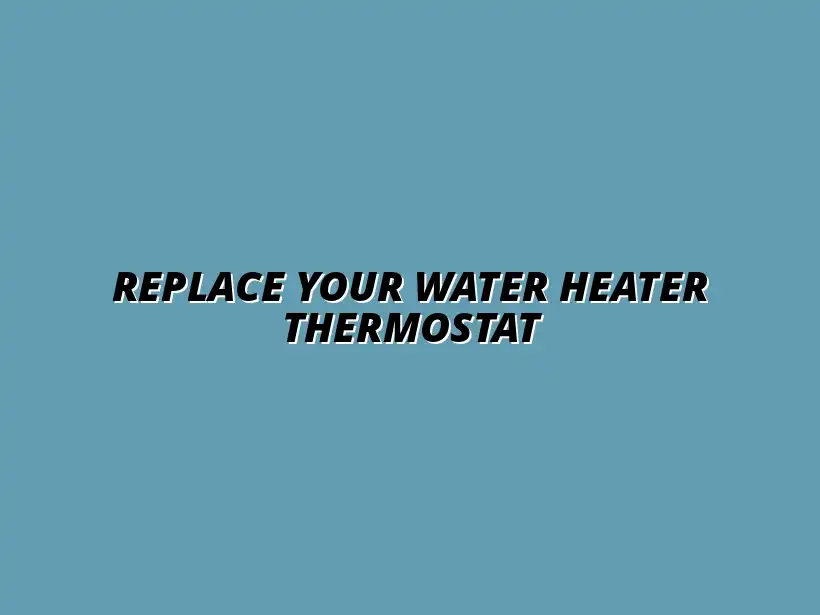
Replace Your Water Heater Thermostat
Understanding the Role of a Water Heater Thermostat
When it comes to ensuring a comfortable home, a water heater thermostat plays a crucial role. It’s the device that regulates the temperature of the water in your heater, making sure it stays within a specific range. Understanding how a thermostat works can help you maintain your water heater effectively and avoid future issues.
In simple terms, a water heater thermostat monitors the temperature of the water and sends signals to the heating element to turn on or off. When the water reaches the set temperature, the thermostat tells the heater to stop heating. This balance keeps your water hot when you need it and prevents overheating, which can be dangerous!
What is a Water Heater Thermostat?
A water heater thermostat is a device that controls the temperature of the water in your heater. It is essential for ensuring that you have hot water available when you need it, without the risk of burns or scalds. In most systems, there are two types of thermostats: manual and electronic.
Manual thermostats require you to adjust the temperature setting, while electronic ones can automatically adjust based on your usage patterns. This allows for greater energy efficiency and convenience! Understanding your thermostat type can help you manage your water heating needs better. For more information on common water heater problems, check out this helpful guide: common water heater issues explained.
Definition and Functionality of a Thermostat
A thermostat is essentially a temperature-sensing device. It detects how hot or cold the water is and communicates this information to the heater. If the water temperature drops below the set point, the thermostat sends a signal to the heating element to start warming up the water again.
This operation is vital for maintaining a consistent water temperature and preventing sudden spikes or drops. A properly functioning thermostat ensures that your water heater runs efficiently, helping you save on energy costs in the long run!
How Thermostats Regulate Water Temperature
Thermostats regulate water temperature through a feedback loop. They constantly check the water’s temperature and adjust the heating process accordingly. This ensures that the water remains at a safe and comfortable temperature, typically between 120°F and 140°F.
Without a properly functioning thermostat, water temperatures can become erratic, leading to discomfort or even hazardous conditions. Regular checks and maintenance of your thermostat can help prevent these issues and ensure a steady supply of hot water when you need it! Learn more about maintaining your water heater efficiently with these tips: maintain your water heater efficiently.
Identifying Symptoms of a Broken Water Heater Thermostat
Recognizing the signs of a broken thermostat is essential for timely repairs. A faulty thermostat can lead to inconsistent water temperatures, which can be quite frustrating! Knowing what to look for can help you catch problems early and avoid costly repairs down the line.
Some common symptoms of a malfunctioning thermostat include:
- Inconsistent water temperatures: Water may be too hot or too cold.
- Frequent cycling: The heater turns on and off more often than usual.
- Unusual noises: Sounds like popping or hissing may indicate an issue.
Common Signs Indicating Thermostat Malfunction
If your water heater isn’t performing as expected, here are a few indicators that your thermostat may be to blame. First, if you notice inconsistent water temperatures, it might be time to investigate. You shouldn’t have to deal with scalding hot or cold showers!
Also, keep an ear out for any unusual noises coming from your water heater. These can be signs of internal problems, including a malfunctioning thermostat. If you catch any of these symptoms early, you can save yourself a lot of trouble later! For example, a leaking water heater pipe can be a serious issue. Learn more about repairing a leaking water heater pipe.
Inconsistent Water Temperatures
One of the first signs of a broken thermostat is inconsistent water temperatures. You might find that sometimes your hot water is scalding, while other times it’s barely warm. This inconsistency can make everyday tasks like showering or washing dishes quite uncomfortable!
When you experience these fluctuations, it’s crucial to check your thermostat. A simple adjustment might solve the problem, but if the issue persists, a replacement may be necessary!
Frequent Cycling of the Water Heater
Another telltale sign of a thermostat issue is frequent cycling of the water heater. If you notice that your heater turns on and off more frequently than normal, it may indicate that the thermostat is malfunctioning. This can lead to increased energy costs and wear on the heater.
Understanding why this happens can help you take action. The thermostat may be incorrectly reading the water temperature, causing it to turn off too soon or not at all. Addressing this issue promptly can help extend the life of your water heater! If you're dealing with other plumbing issues, like a running toilet, you might find this helpful: fix a running toilet easily.
Unusual Noises from the Heater
Lastly, if you hear unusual noises from your heater, such as popping or banging sounds, it could be a sign of a faulty thermostat or other internal issues. While some noise is normal, excessive or strange noises might indicate problems that need to be addressed. Don’t ignore these sounds!
Pay attention to when these noises happen. If they coincide with the heater cycling on and off, it’s likely that the thermostat is at fault. Keeping an ear out for these signs can help you keep your water heater in its best shape!
Safety Concerns Related to a Faulty Thermostat
It’s important to recognize that a faulty thermostat can pose safety risks. One of the biggest concerns is the risk of scalding water. If the thermostat fails to regulate the temperature properly, you could be in for a nasty surprise when you step into the shower!
In addition to the risk of burns, a malfunctioning thermostat can also lead to damage to your water heater. Overheating can cause significant wear and tear, resulting in costly repairs or even the need for a complete replacement. Staying vigilant about your thermostat’s performance can help prevent these issues!
The Risks of Scalding Water
Scalding water can be a serious hazard, especially for children or elderly individuals. If the thermostat isn’t functioning correctly, it could allow temperatures to reach dangerous levels. Keeping your water heater set to a safe temperature is essential for household safety!
To avoid the risks of scalding, it’s a good idea to routinely check your thermostat settings. Setting the temperature to around 120°F can help minimize the risk while still providing enough hot water for your needs!
Potential Damage to the Water Heater
Another concern regarding a faulty thermostat is potential damage to the water heater itself. If the unit overheats, it can lead to premature failure of the heating elements and other components. This could result in expensive repairs or the need for a full replacement!
Keeping an eye on your thermostat's performance is key to maintaining the overall health of your water heater. Regular maintenance checks can help ensure that everything is functioning smoothly and safely. For quick solutions to common sink issues, see our guide on quick ways to unblock a sink.
Preparing for the Replacement Process
When replacing a thermostat, preparation is crucial. Gathering the right tools and materials can make the process much smoother and safer! You don’t want to be scrambling for tools while in the middle of a project.
Before diving into the replacement, take some time to gather everything you’ll need. This will help you avoid interruptions and ensure you can complete the task efficiently!
Gathering Necessary Tools and Materials
Here’s a list of tools and materials you’ll need for replacing a water heater thermostat:
- Screwdriver: For opening the thermostat cover.
- Multimeter: To test electrical connections.
- Pipe wrench: For any plumbing adjustments.
- Replacement thermostat: Make sure it’s compatible with your heater!
Having these tools on hand will help ensure a smooth replacement process. It’s always better to be over-prepared than under-prepared!
List of Tools Required for Thermostat Replacement
Here’s a more detailed list of tools you might need:
- Screwdrivers (both Phillips and flathead)
- Multimeter for electrical testing
- Adjustable wrench or pliers
- Replacement thermostat compatible with your model
- Protective gloves for safety
By having everything ready, you’ll find the replacement process much less stressful. Plus, you’ll feel more confident about tackling the task! If you're tackling a kitchen plumbing repair, you might find this helpful: repairing a leaky kitchen sink.
Essential Parts and Components Needed
Along with tools, you’ll need some essential parts for the thermostat replacement. Here’s what to look out for:
- Thermostat: Ensure it matches your water heater type.
- Thermal insulation tape: For sealing any connections.
- Wiring connectors: To securely connect wires.
Having these parts ready before you start will help you avoid delays. It’s always nice to have everything you need right at your fingertips!
Safety Precautions Before Starting the Replacement
Before you begin replacing the thermostat, it’s important to consider safety. Turning off the power and water supply is the first step in ensuring a safe environment for the replacement process. This will prevent any accidental shocks or leaks!
Additionally, proper ventilation is important. Working in a well-ventilated area can help reduce the risk of inhaling any fumes or other hazards. Taking these precautions seriously can keep you safe while you get the job done! For plumbing services in Billesley, Birmingham, check out plumber in Billesley, Birmingham.
Turning Off Power and Water Supply
Before you do anything else, make sure to turn off the power to the water heater. This is usually accomplished by switching off the circuit breaker. It’s also wise to turn off the water supply to avoid any leaks during the replacement.
After you’ve done this, double-check that the power is off using a multimeter. Ensuring everything is powered down will keep you safe while you work on the heater!
Importance of Proper Ventilation
Proper ventilation is essential during any repair work. Make sure your workspace is well-ventilated to help prevent the buildup of any harmful fumes. Open windows or use fans to ensure that fresh air is circulating, so you can work comfortably and safely.
By following these safety precautions, you’ll set yourself up for a successful replacement process. Remember, taking your time and being careful is key to ensuring everything goes smoothly!
Step-by-Step Guide to Replace a Broken Water Heater Thermostat
Replacing a broken water heater thermostat might sound tricky, but with the right guidance, you can tackle it with confidence! This step-by-step guide will walk you through the entire process, ensuring that you can restore your water heater's functionality without unnecessary hassle. Let’s get started!
Draining the Water Heater
Before replacing the thermostat, it’s crucial to drain your water heater properly. This helps ensure safety and prevents water damage during the replacement process. You can follow these steps to drain your water heater safely:
- Turn off the power: Shut off the power supply to the water heater to avoid any electrical hazards.
- Close the cold water supply valve: This prevents more water from entering the tank while you’re draining it.
- Attach a hose to the drain valve: Connect a garden hose to the drain valve at the bottom of the tank.
- Open the drain valve: Allow the water to flow out through the hose into a suitable container or outside.
Tips for Reducing Water Pressure Before Draining
Effective draining requires that you reduce water pressure within the tank. Here are some helpful tips:
- Open a hot water tap: This helps release any built-up pressure, making it easier to drain the tank.
- Wait for the water to cool: Allowing the water to cool down minimizes the risk of burns when draining.
Following these tips will make the draining process smoother and safer!
Removing the Faulty Thermostat
Once the water heater is drained, it's time to remove the faulty thermostat. This step requires careful handling to avoid damaging components. Here’s how to access and remove the thermostat:
Accessing the Thermostat Compartment
Locate the thermostat compartment on your water heater, often near the top or bottom of the unit. You’ll usually need to:
- Unscrew the access panel using a screwdriver.
- Carefully remove any insulation that might be in the way.
Disconnecting Wires and Components
With the access panel open, you can disconnect the wires safely. Here’s what to do:
- Take a picture: Document the wire connections for easier installation later!
- Carefully unclip or unscrew the wires: Make sure to keep track of which wire goes where.
- Remove the thermostat: Unscrew or unclip the thermostat from its mounting.
Installing the New Thermostat
Now that the old thermostat is out, it’s time to install the new one. Follow these simple steps for a successful installation:
Connecting Wires to the New Thermostat
Refer back to the picture you took earlier to connect the wires to the new thermostat correctly. Make sure they are tightly secured to avoid any electrical issues!
Securely Placing the Thermostat in Position
Once wired up, carefully place the thermostat back into its mounting position. Make sure it fits snugly and is properly aligned before you reattach any coverings.
Restoring Power and Testing the New Thermostat
With the new thermostat in place, it’s time to restore power and ensure everything is functioning correctly. Here’s how to do it:
Steps to Refill and Restore Power to the Water Heater
- Close the drain valve: Ensure it is tightly closed to prevent leaks.
- Open the cold water supply valve: Allow water to refill the tank.
- Turn the power back on: Restore power to the water heater.
How to Test if the New Thermostat is Functioning Properly
To ensure the thermostat is working, check the water temperature after a few hours. If it’s consistent and at your desired temperature, congratulations, you did it!
FAQs Related to Water Heater Thermostat Replacement
Replacing a thermostat can raise questions. Let’s tackle some common ones!
What are the Costs Involved in Replacing a Thermostat?
The cost can vary based on the brand and model, but generally, the thermostat itself can be quite affordable. Professional labor may add to the expense if you decide to hire someone.
How Long Does the Replacement Process Take?
Most DIY enthusiasts can complete this task in about 1 to 2 hours, depending on their familiarity with the equipment!
Can I Replace a Water Heater Thermostat Myself?
Absolutely! With the right tools and guidance, many homeowners can comfortably replace a thermostat on their own.
Final Thoughts on Maintaining Your Water Heater
Regular maintenance of your water heater not only extends its lifespan but also improves efficiency. Make sure to schedule checks annually!
Importance of Regular Maintenance Checks
Keeping an eye on your water heater can help catch issues before they become major problems. Regular maintenance can save you money in the long run!
When to Consult a Professional for Water Heater Issues
If you encounter persistent problems or feel uncomfortable with repairs, it's best to call a professional. They can provide expert advice and service!
